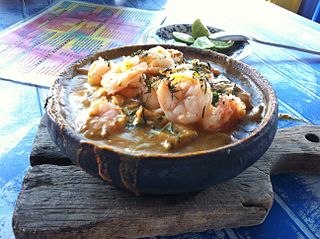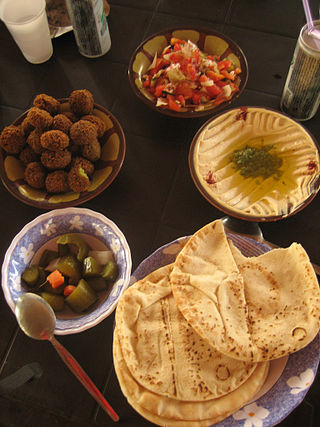
A salad is a dish consisting of mixed ingredients, frequently vegetables. They are typically served chilled or at room temperature, though some can be served warm. Condiments and salad dressings, which exist in a variety of flavors, are often used to enhance a salad.

Tostada is the name given to various dishes in Mexico and Guatemala which include a toasted tortilla as the main base of their preparation.
The doctrine of lapsation was a policy of annexation initiated by the East India Company in the Indian subcontinent for the princely states, and applied until the year 1858, the year after Company rule was succeeded by the British Raj under the British Crown.

Bouillabaisse is a traditional Provençal fish soup originating in the port city of Marseille. The French and English form bouillabaisse comes from the Provençal Occitan word bolhabaissa, a compound that consists of the two verbs bolhir and abaissar.

Assamese cuisine is the cuisine of the Indian state of Assam. It is a style of cooking that is a confluence of cooking habits of the hills that favour fermentation and drying as forms of preservation and those from the plains that provide extremely wide variety of fresh vegetables and greens, and an abundance of fish and meat. Both are centred on the main ingredient — rice. It is a mixture of different indigenous styles with considerable regional variations and some external influences. The traditional way of cooking and the cuisine of Assam is very similar to South-East Asian countries such as Thailand, Burma (Myanmar) and others. The cuisine is characterized by very little use of spices, little cooking over fire, and strong flavours due mainly to the use of endemic exotic fruits and vegetables that are either fresh, dried or fermented. Fish is widely used, and birds like duck, pigeon, squab, etc. are very popular, which are often paired with a main vegetable or ingredient; beef used to be eaten before British colonialism, and some continue to do so. Preparations are rarely elaborate. The practice of bhuna, the gentle frying of spices before the addition of the main ingredients so common in Indian cooking, is absent in the cuisine of Assam. The preferred oil for cooking is the pungent mustard oil.

A gordita in Mexican cuisine is a dish made with masa and stuffed with cheese, meat, or other fillings. It is similar to the Colombian and Venezuelan arepa. Gordita means "chubby" in Spanish. There are two main variations of this dish, one of which is typically fried in a deep wok-shaped comal, consumed mostly in central and southern Mexico, and another one baked on a regular comal. The most common and representative variation of this dish is the "gordita de chicharrón", filled with chicharron which is widely consumed throughout Mexico. Gorditas are often eaten as a lunch dish and accompanied by several types of sauce.

Kimchi fried rice or kimchi-bokkeum-bap (김치볶음밥) is a variety of bokkeum-bap, a popular dish in South Korea. Kimchi fried rice is made primarily with kimchi and rice, along with other available ingredients, such as diced vegetables or meats like Spam.

Okróshka is a cold soup of Russian origin, which probably originated in the Volga region.

Wingko, wiwingka or bibika, which is sometimes called wingko babat, wiwingka or bibika, is a traditional Indonesian pancake-like snack made from coconuts. This kue is usually associated with Javanese cuisine.
Salmagundi is a cold dish or salad made from different ingredients which may include meat, seafood, eggs, cooked and raw vegetables, fruits, or pickles. In English culture, the term does not refer to a single recipe but describes the grand presentation of a large plated salad of many disparate ingredients. These can be arranged in layers or geometrical designs on a plate or mixed. The ingredients are then drizzled with a dressing. The dish includes a wide range of flavours and colours and textures on a single plate. Often recipes allow the cook to add various ingredients which may be available at hand, producing many variations of the dish. Flowers from broom and sweet violet were often used.

Cazuela is the common name given to a variety of dishes, especially from South America. It receives its name from the cazuela – traditionally, an often shallow pot made of unglazed earthenware used for cooking. The ingredients and preparation vary from region to region, but it is usually a mid-thick flavoured stock obtained from cooking several kinds of meats and vegetables mixed together.
Amendolara is a town and comune in the province of Cosenza in the Calabria region of southern Italy.

Sirmur was an independent kingdom in India, founded in 1616, located in the region that is now the Sirmaur district of Himachal Pradesh. The state was also known as Nahan, after its main city, Nahan. The state ranked predominant amongst the Punjab hill States. It had an area of 4,039 km2 and a revenue of 300,000 rupees in 1891.

Uttarakhand is a state in North India. Its name, which means "northern land" or "section" or "northern part" in Sanskrit, is mentioned in early Hindu texts as the combined region of Kedarkhand and Manaskhand.

Misal, is a very popular spicy dish in the Western Indian state of Maharashtra. The dish is mostly eaten for breakfast or as a midday snack or sometimes as a one-dish meal, often as part of misal pav. It remains a favourite snack since it is easy to make with affordable ingredients and has a good nutritional value. The taste of misal ranges from mildly to extremely spicy. And there are a lot of varieties as well. Misal is also a popular street food. The dish is always served hot.

Jordanian cuisine is a Middle Eastern cuisine that has the traditional style of food preparation originating from, or commonly used in, Jordan that has developed through centuries of social and political change.

Mole, pronounced[ˈmole], from Nahuatl mōlli meaning "sauce", is a traditional sauce and marinade originally used in Mexican cuisine. In contemporary Mexico the term is used for a number of sauces, some quite dissimilar, including mole amarillo or amarillito, mole chichilo, mole colorado or coloradito, mole manchamantel or manchamanteles, mole negro, mole rojo, mole verde, mole poblano, mole almendrado, mole michoacano, mole prieto, mole ranchero, mole tamaulipeco, mole xiqueno, mole pipián, mole rosa, mole blanco, chimole, guacamole and huaxmole.

The cuisine of Chiapas is a style of cooking centered on the Mexican state of the same name. Like the cuisine of rest of the country, it is based on corn with a mix of indigenous and European influences. It distinguishes itself by retaining most of its indigenous heritage, including the use of the chipilín herb in tamales and soups, used nowhere else in Mexico. However, while it does use some chili peppers, including the very hot simojovel, it does not use it as much as other Mexican regional cuisines, preferring slightly sweet seasoning to its main dishes. Large regions of the state are suitable for grazing and the cuisine reflects this with meat, especially beef and the production of cheese. The most important dish is the tamal, with many varieties created through the state as well as dishes such as chanfaina, similar to menudo and sopa de pan. Although it has been promoted by the state of Chiapas for tourism purposes as well as some chefs, it is not as well known as other Mexican cuisine, such as that of neighboring Oaxaca.

Char kway teow is a stir-fried rice noodle dish from Maritime Southeast Asia of southern Chinese origin. In Hokkien and Teochew, char means 'stir-fried' and kway teow refers to flat rice noodles. It is made from flat rice noodles or kway teow of approximately 1 cm or about 0.5 cm in width, stir-fried over very high heat with garlic, light and dark soy sauce, chili paste, whole prawns, shelled blood cockles, chopped Chinese chives, slices of Chinese sausage, and bean sprouts. Other common ingredients include fishcake and belachan.

Seblak is an Sundanese savoury and spicy dish, originating from the Sundanese region in West Java, Indonesia. Made of wet krupuk cooked with protein sources in spicy sauce. Seblak is a specialty of Bandung city, West Java, Indonesia. Seblak can be acquired from restaurants, warungs or gerobak (cart) street vendors. It is one of the most popular street foods in Indonesia, especially in Bandung and Jakarta.
















